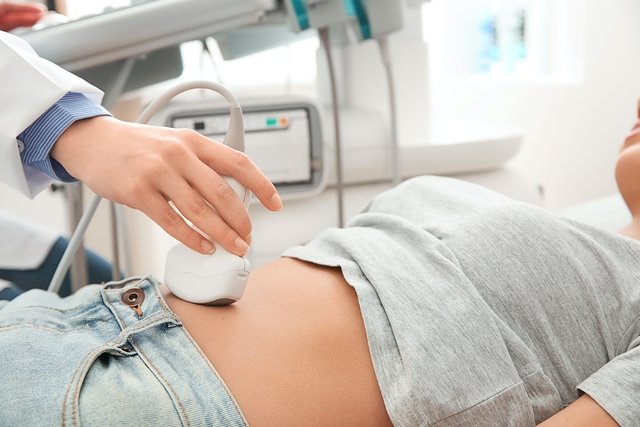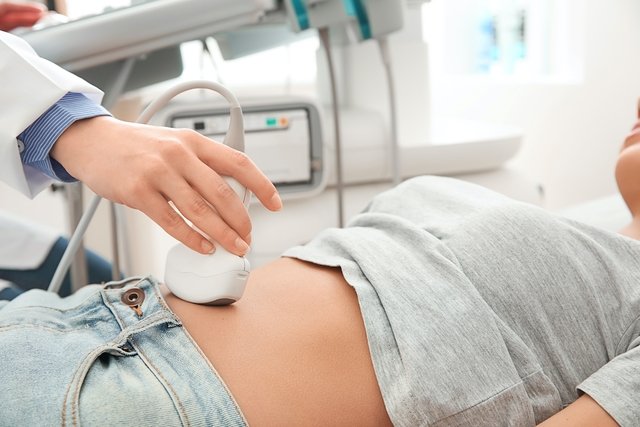Spontaneous abortion is the involuntary termination of pregnancy before 20 weeks of gestation, which generally occurs due to malformation of the fetus, but can also occur due to viral or bacterial infections.
Symptoms of miscarriage include severe abdominal pain, vaginal discharge, and blood loss from the vagina. It is more common in the first 12 weeks of pregnancy, and often, it may not even be noticed by the woman, especially if it occurs in the first 6 weeks, as it can be confused with menstruation. Learn how to identify whether it is a miscarriage or menstruation.
Treatment for miscarriage should be carried out as quickly as possible, and the nearest emergency room should be sought as soon as symptoms appear, so that the diagnosis can be made, avoiding complications such as sepsis due to products of conception retained in the uterus.

Symptoms of miscarriage
The main symptoms of miscarriage are:
- Vaginal bleeding;
- Severe abdominal pain, similar to intense menstrual cramps, which can radiate to the back;
- Fever or chills;
- Bad-smelling vaginal discharge;
- Loss of blood clots or tissues through the vagina;
- Absence of natural signs of pregnancy, such as breast tenderness or nausea;
- Absence of fetal movements for more than 5 hours.
Additionally, these symptoms may be accompanied by heart palpitations or a drop in blood pressure. See other symptoms of miscarriage.
It is important to seek immediate medical attention or the nearest emergency room, if symptoms of a miscarriage appear, so that it can be diagnosed and treatment can begin.
What to do if you suspect a miscarriage
If a woman presents signs and symptoms such as severe abdominal pain and blood loss from the vagina, especially after intimate contact, it is recommended to go to the doctor for tests such as an ultrasound to check whether the baby and the placenta are ok.
The doctor may recommend that the woman rest and avoid intimate contact for 15 days, but it may also be necessary to take painkillers and antispasmodics to relax the uterus and avoid contractions that lead to miscarriage.
How to confirm the diagnosis
The diagnosis of miscarriage is made by the obstetrician through analysis of symptoms, gynecological pelvic examination, blood test measuring the levels of beta-HCG, hemoglobin and hematocrit, and through pelvic or transvaginal ultrasound. This way, the doctor can diagnose the type of abortion.
Furthermore, in the case of women who do not yet know their blood type, the doctor may request a blood test to determine the maternal blood type and the Rh factor, if a blood transfusion or recommendation for the administration of anti-D immunoglobulin is necessary. Find out how the Rh factor can influence pregnancy.
Other tests that the doctor may order to determine the cause of the miscarriage, such as gonorrhea or chlamydia infections, for example, are a urine test and analysis of vaginal secretions and products of conception.
Types of miscarriage
Abortion can be classified into some types according to the characteristics of the cervix and expulsion of uterine contents, which may occur completely, incompletely or not at all.
The main types of miscarriage include:
- Threat of abortion: occurs when a woman has vaginal bleeding, but the cervix is not dilated. Generally, in this type, the pregnancy continues without major risks;
- Complete abortion: when all uterine contents are expelled, without the need for surgical intervention, being more common in the first 12 weeks of pregnancy;
- Incomplete abortion: when only part of the uterine contents is expelled, and parts of the fetus, placenta or membranes may still be retained in the uterus;
- Missed miscarriage: when fetal death occurs, and the woman does not present any uterine activity to expel the fetus, which remains retained in the uterus for 4 weeks or more;
- Inevitable miscarriage: occurs when the cervix has dilated but the products of conception have not been expelled.
Furthermore, another type of miscarriage is septic miscarriage, which develops when uterine infection occurs.
Possible causes
The main causes of miscarriage are:
- Fetal malformation;
- Hormonal changes, such as lack of progesterone;
- Problems in the uterus, such as a bicornuate, septate, arched uterus or deformity in the endometrium;
- Problems in the cervix, such as isthmus-cervical insufficiency;
- Polycystic ovary syndrome;
- Thyroid diseases, such as hypo- or hyperthyroidism;
- Infections caused by viruses or bacteria, such as gonorrhea, chlamydia, syphilis, mycoplasma or toxoplasmosis;
- Uncontrolled diabetes;
- Thrombophilia;
- Celiac disease;
- Autoimmune diseases, especially antiphospholipid antibody syndrome;
- History of two or more miscarriages;
- Pregnancy after age 35;
- Conception within three to six months after birth;
- Use of intra-uterine device (IUD);
- Exaggerated consumption of alcoholic beverages or those containing caffeine;
- Use of drugs of abuse;
- Exposure to cigarette smoke;
- Low weight or obesity;
- Invasive prenatal tests, such as amniocentesis or chorionic villus sampling.
Furthermore, taking medicines or teas without medical advice can also cause a miscarriage. Learn about some medications that can cause miscarriage.
How the treatment is carried out
The treatment of miscarriage must be guided by the obstetrician-gynecologist and depends on the type of miscarriage the woman suffered. In the case of an incomplete abortion, the doctor may recommend the use of medicines such as Cytotec for complete elimination and then may perform curettage or manual or vacuum aspiration to remove tissue remains and clean the woman’s uterus, preventing infections. Find out how curettage is done.
When there are signs of uterine infection such as foul odor, vaginal discharge, severe abdominal pain, rapid heartbeat and fever, the doctor may prescribe antibiotics in the form of injections and uterine scraping. In more serious cases, it may be necessary to remove the woman’s uterus.
When to get pregnant again
After suffering an abortion, a woman must receive psychological support from professionals, family and friends to recover emotionally from the trauma caused by the loss of the baby.
The woman can try to get pregnant again after 3 months after the abortion, waiting for her menstruation to return to normal, having at least 2 menstrual cycles or after this period when she feels safe again to try a new pregnancy.
Bibliography
- WORLD HEALTH ORGANIZATION. Abortion Care Guideline: Summary . Available at: <https://www.who.int/pt/publications/i/item/9789240045163>. Accessed on 30 Nov 2022
- GRIEBEL, CP; et al. Management of Spontaneous Abortion. Am Fam Physician. 72. 7; 1243-1250, 2005
- ALVES, C.; RAPP, A. IN: STATPEARLS (INTERNET). TREASURE ISLAND (FL): STATPEARLS PUBLISHING. Spontaneous Abortion. 2020. Available at: <https://www.ncbi.nlm.nih.gov/books/NBK560521/>. Accessed on April 29, 2022

Sign up for our newsletter and stay up to date with exclusive news
that can transform your routine!
Warning: Undefined array key "title" in /home/storelat/public_html/wp-content/plugins/link-whisper-premium/templates/frontend/related-posts.php on line 12
Warning: Undefined array key "title_tag" in /home/storelat/public_html/wp-content/plugins/link-whisper-premium/templates/frontend/related-posts.php on line 13





